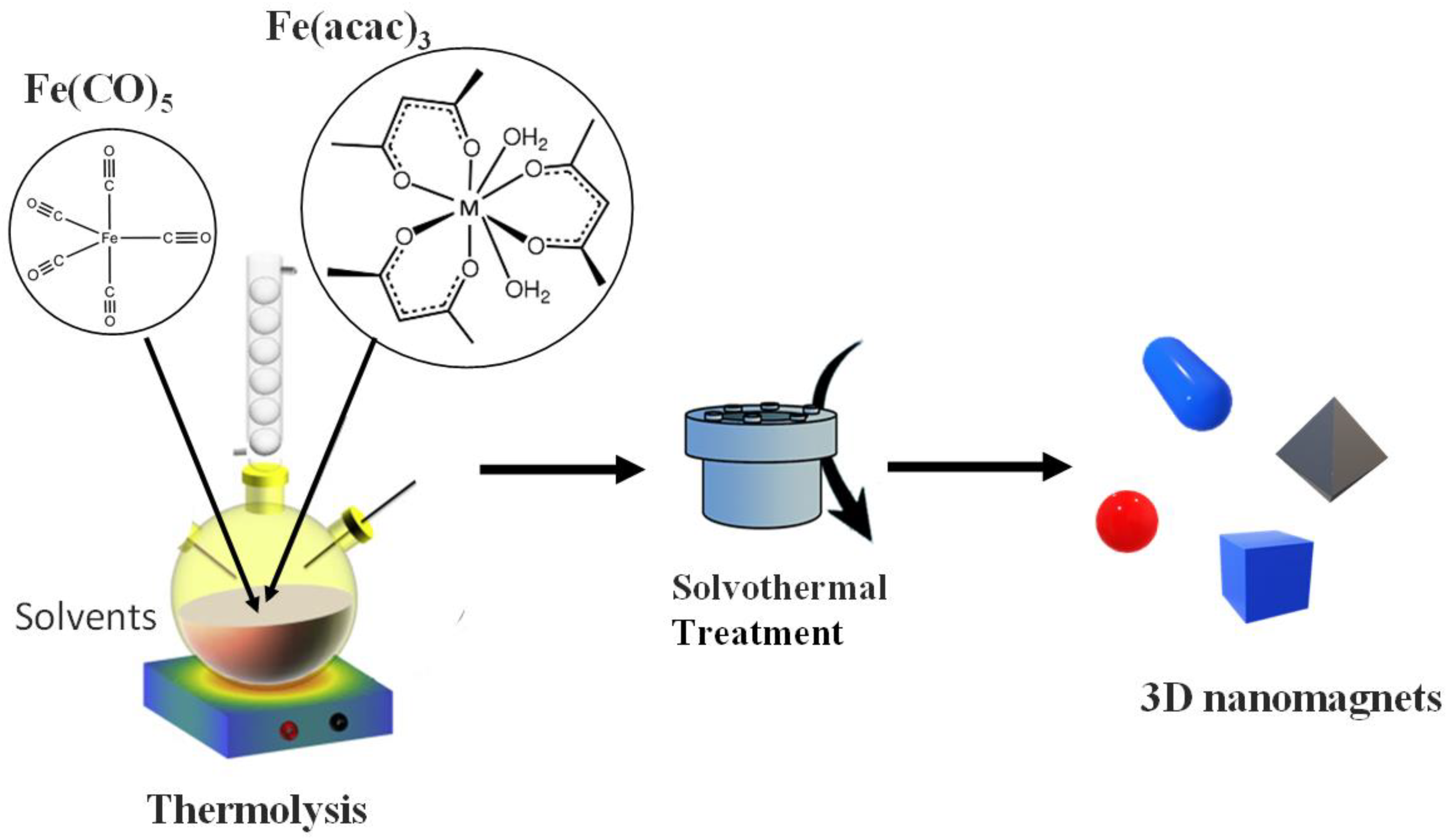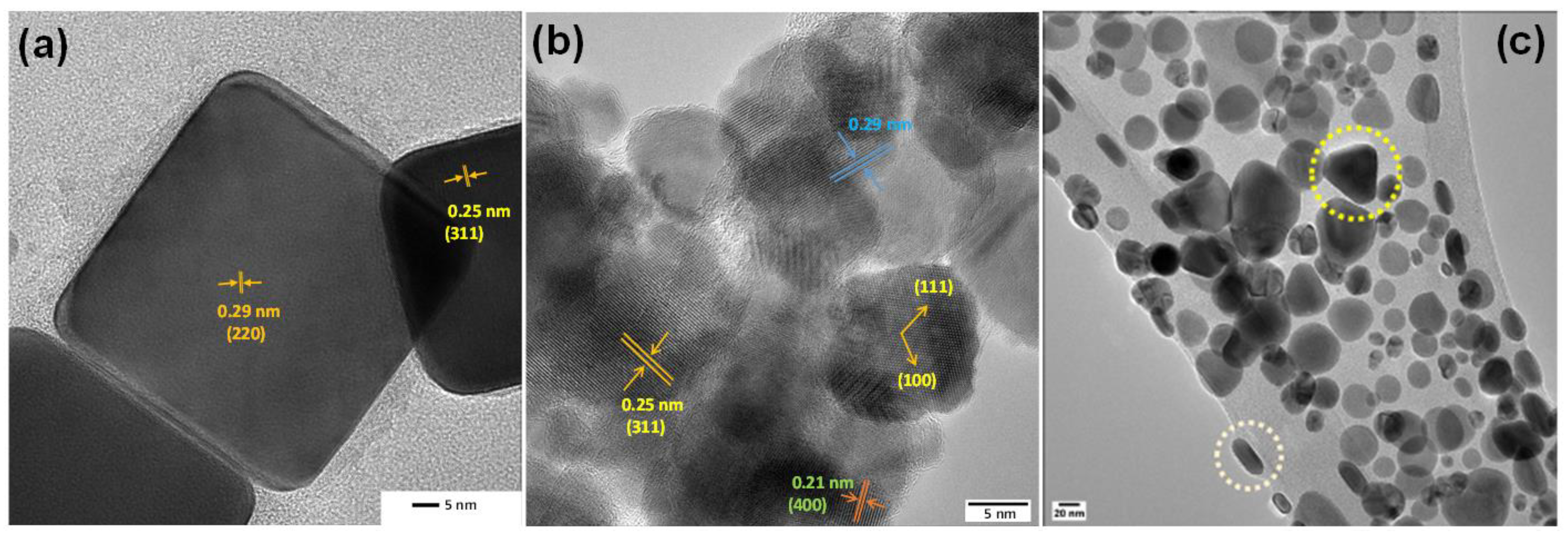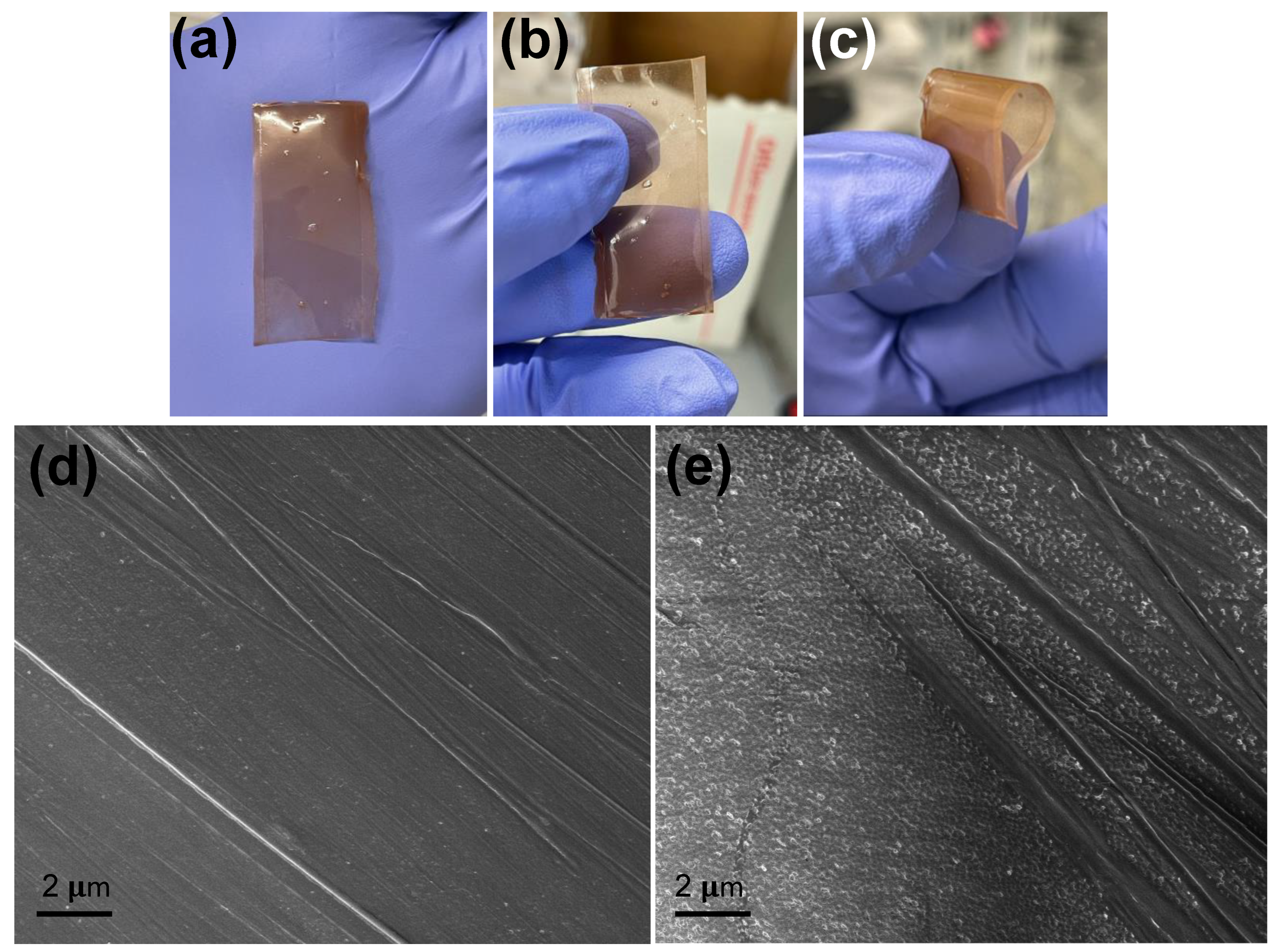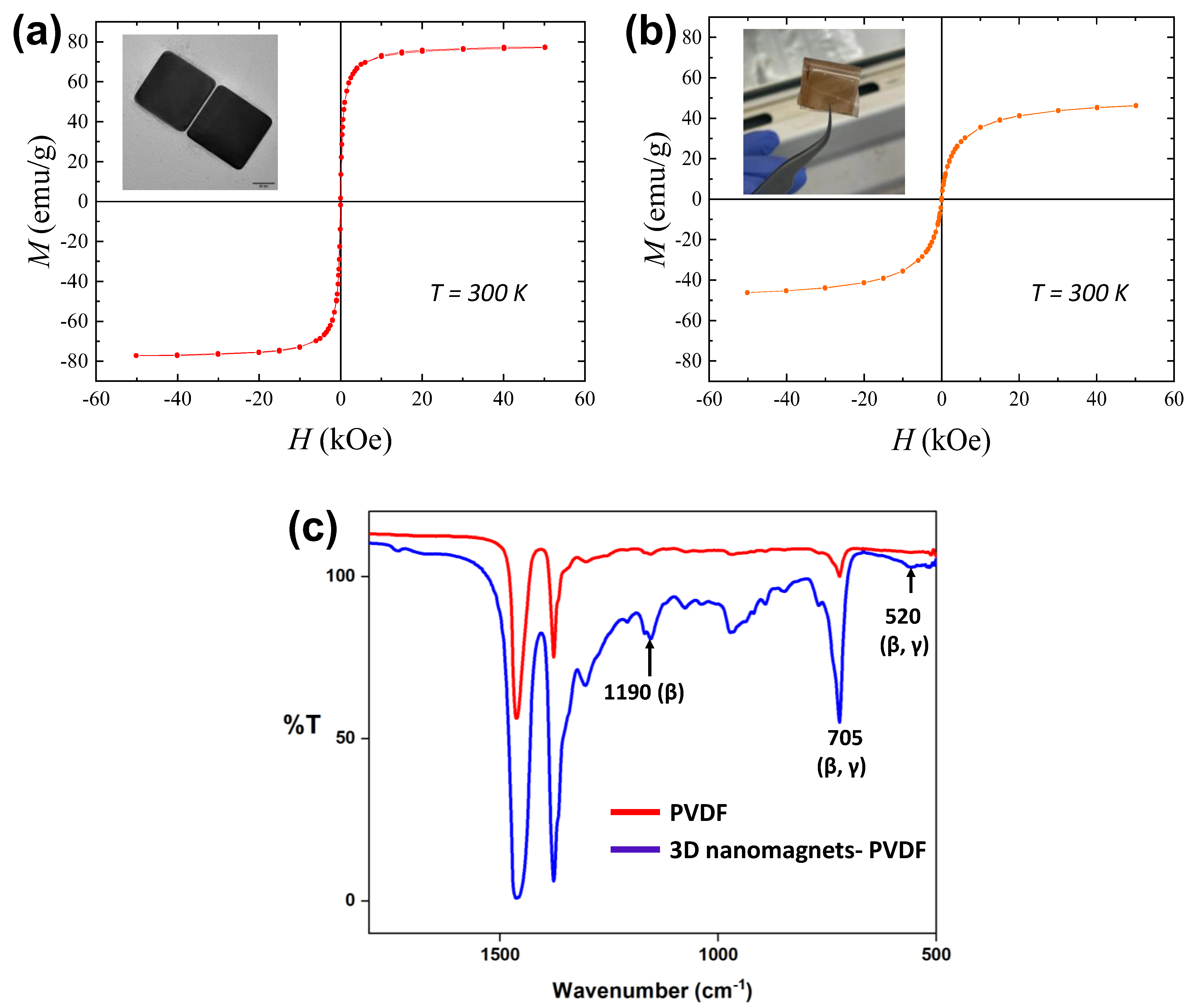The Synthesis of Anisotropic 3D Nanomagnets for Magnetic Actuation and Sensing in Piezoelectric Polyvinylidene Fluoride towards Magnetic Nanogenerator Device Fabrication †
Abstract
:1. Introduction
2. Materials and Methods
2.1. Synthesis of 3D Nanomagnets
2.2. Preparation of 3D Nanomagnet–PVDF Composites and Thin Films
2.3. Morphological and Magnetic Characterisations
3. Results and Discussion
4. Conclusions
Author Contributions
Funding
Institutional Review Board Statement
Informed Consent Statement
Data Availability Statement
Conflicts of Interest
References
- Annapureddy, V.; Palneedi, H.; Hwang, G.T.; Peddigari, M.; Jeong, D.Y.; Yoon, W.H.; Kim, K.H.; Ryu, J. Magnetic energy harvesting with magnetoelectrics: An emerging technology for self-powered autonomous systems. Sustain. Energy Fuels 2017, 1, 2039–2052. [Google Scholar] [CrossRef]
- Ryu, J.; Kang, J.E.; Zhou, Y.; Choi, S.Y.; Yoon, W.H.; Park, D.S.; Choi, J.J.; Hahn, B.D.; Ahn, C.W.; Kim, J.W.; et al. Ubiquitous magneto-mechano-electric generator. Energy Environ. Sci. 2015, 8, 2402–2408. [Google Scholar] [CrossRef]
- Lee, H.; Sriramdas, R.; Kumar, P.; Sanghadasa, M.; Kang, M.G.; Priya, S. Maximizing power generation from ambient stray magnetic fields around smart infrastructures enabling self-powered wireless devices. Energy Environ. Sci. 2020, 13, 1462–1472. [Google Scholar] [CrossRef]
- Dai, X.; Wen, Y.; Li, P.; Yang, J.; Li, M. Energy harvesting from mechanical vibrations using multiple magnetostrictive/piezoelectric composite transducers. Sens. Actuators A Phys. 2011, 166, 94–101. [Google Scholar] [CrossRef]
- Hu, X. Increased effective piezoelectric response of structurally modulated P(VDF-TrFE) film devices for effective energy harvesters. Mater. Des. 2020, 192, 108700. [Google Scholar] [CrossRef]
- Annapureddy, V.; Na, S.M.; Hwang, G.T.; Kang, M.G.; Sriramdas, R.; Palneedi, H.; Yoon, W.H.; Hahn, B.D.; Kim, J.W.; Ahn, C.W.; et al. Exceeding milli-watt powering magneto-mechano-electric generator for standalone-powered electronics. Energy Environ. Sci. 2018, 11, 818–829. [Google Scholar] [CrossRef]
- Lim, K.W.; Peddigari, M.; Park, C.H.; Lee, H.Y.; Min, Y.; Kim, J.W.; Ahn, C.W.; Choi, J.J.; Hahn, B.D.; Choi, J.H.; et al. A high output magneto-mechano-triboelectric generator enabled by accelerated water-soluble nano-bullets for powering a wireless indoor positioning system. Energy Environ. Sci. 2019, 12, 666–674. [Google Scholar] [CrossRef]
- Al-Ashtari, W.; Hunstig, M.; Hemsel, T.; Sextro, W. Frequency Tuning of Piezoelectric Energy Harvesters by Magnetic Force. Smart Mater. Struct. 2012, 21, 035019. [Google Scholar] [CrossRef]
- Narita, F.; Fox, M. A review on piezoelectric, magnetostrictive, and magnetoelectric materials and device technologies for energy harvesting applications. Adv. Eng. Mater. 2018, 20, 1700743. [Google Scholar] [CrossRef]
- Ahn, C.-W.; Choi, C.-H.; Park, H.-Y.; Nahm, S.; Priya, S. Dielectric and Piezoelectric Properties of (1–x)(Na0. 5K0. 5) NbO3–xBaTiO3 Ceramics. J. Mater. Sci. 2008, 43, 6784–6797. [Google Scholar] [CrossRef]
- Fernández-Pacheco, A.; Streubel, R.; Fruchart, O.; Hertel, R.; Fischer, P.; Cowburn, R.P. Three-dimensional nanomagnetism. Nat. Commun. 2017, 8, 15756. [Google Scholar] [CrossRef] [PubMed]
- Faure, B.; Wetterskog, E.; Gunnarsson, K.; Josten, E.; Hermann, R.P.; Brückel, T.; Andreasen, J.W.; Meneau, F.; Meyer, M.; Lyubartsev, A.; et al. 2D to 3D crossover of the magnetic properties in ordered arrays of iron oxide nanocrystals. Nanoscale 2013, 5, 953–960. [Google Scholar] [CrossRef] [PubMed]
- Anagnostopoulou, E.; Grindi, B.; Lacroix, L.M.; Ott, F.; Panagiotopoulos, I.; Viau, G. Dense arrays of cobalt nanorods as rare-earth free permanent magnets. Nanoscale 2016, 8, 4020–4029. [Google Scholar] [CrossRef] [PubMed]
- Ma, Z.; Mohapatra, J.; Wei, K.; Liu, J.P.; Sun, S. Magnetic Nanoparticles: Synthesis, Anisotropy, and Applications. Chem. Rev. 2023, 123, 3904–3943. [Google Scholar] [CrossRef]
- Soran-Erdem, Z.; Sharma, V.K.; Hernandez-Martinez, P.L.; Demir, H.V. Tailored Synthesis of Iron Oxide Nanocrystals for Formation of Cuboid Mesocrystals. ACS Omega 2021, 6, 20351–20360. [Google Scholar] [CrossRef]
- Niculaes, D.; Lak, A.; Anyfantis, G.C.; Marras, S.; Laslett, O.; Avugadda, S.K.; Cassani, M.; Serantes, D.; Hovorka, O.; Chantrell, R.; et al. Asymmetric assembling of iron oxide nanaocubes for improving magnetic hyperthermia performance. ACS Nano 2017, 11, 12121–12133. [Google Scholar] [CrossRef]
- Achadu, O.J.; Nwaji, N.; Lee, D.; Lee, J.; Akinoglu, E.M.; Giersig, M.; Park, E.Y. 3D hierarchically porous magnetic molybdenum trioxide@gold nanospheres as a nanogap-enhanced Raman scattering biosensor for SARS-CoV-2. Nanoscale Adv. 2022, 4, 871–883. [Google Scholar] [CrossRef] [PubMed]
- Tamang, A.; Ghosh, S.K.; Garain, S.; Alam, M.M.; Haeberle, J.; Henkel, K.; Schmeisser, D.; Mandal, D. DNA-Assisted β-phase Nucleation and Alignment of Molecular Dipoles in PVDF Film: A Realization of Self-Poled Bioinspired Flexible Polymer Nanogenerator for Portable Electronic Devices. ACS Appl. Mater. Interfaces 2015, 7, 16143. [Google Scholar] [CrossRef]




Disclaimer/Publisher’s Note: The statements, opinions and data contained in all publications are solely those of the individual author(s) and contributor(s) and not of MDPI and/or the editor(s). MDPI and/or the editor(s) disclaim responsibility for any injury to people or property resulting from any ideas, methods, instructions or products referred to in the content. |
© 2023 by the authors. Licensee MDPI, Basel, Switzerland. This article is an open access article distributed under the terms and conditions of the Creative Commons Attribution (CC BY) license (https://creativecommons.org/licenses/by/4.0/).
Share and Cite
Achadu, O.J.; Elizur, G.L.; Bankole, O.M. The Synthesis of Anisotropic 3D Nanomagnets for Magnetic Actuation and Sensing in Piezoelectric Polyvinylidene Fluoride towards Magnetic Nanogenerator Device Fabrication. Eng. Proc. 2023, 58, 101. https://doi.org/10.3390/ecsa-10-16228
Achadu OJ, Elizur GL, Bankole OM. The Synthesis of Anisotropic 3D Nanomagnets for Magnetic Actuation and Sensing in Piezoelectric Polyvinylidene Fluoride towards Magnetic Nanogenerator Device Fabrication. Engineering Proceedings. 2023; 58(1):101. https://doi.org/10.3390/ecsa-10-16228
Chicago/Turabian StyleAchadu, Ojodomo J., Gideon L. Elizur, and Owolabi M. Bankole. 2023. "The Synthesis of Anisotropic 3D Nanomagnets for Magnetic Actuation and Sensing in Piezoelectric Polyvinylidene Fluoride towards Magnetic Nanogenerator Device Fabrication" Engineering Proceedings 58, no. 1: 101. https://doi.org/10.3390/ecsa-10-16228
APA StyleAchadu, O. J., Elizur, G. L., & Bankole, O. M. (2023). The Synthesis of Anisotropic 3D Nanomagnets for Magnetic Actuation and Sensing in Piezoelectric Polyvinylidene Fluoride towards Magnetic Nanogenerator Device Fabrication. Engineering Proceedings, 58(1), 101. https://doi.org/10.3390/ecsa-10-16228






